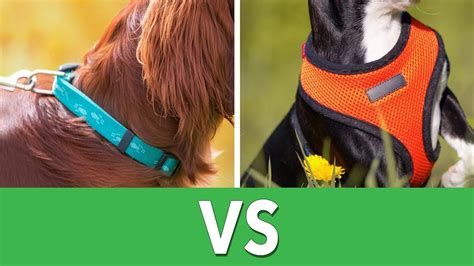Introduction

When it comes to keeping your canine companion safe and comfortable during walks and adventures, the choice between a harness and a collar can be a crucial one. Both options have their own set of pros and cons, and the best choice for your dog will depend on their individual needs and preferences. In this comprehensive article, we will delve into the key differences between dog harnesses and collars, examining their advantages and disadvantages in various situations. By the end, you’ll be fully equipped to make an informed decision that ensures your furry friend’s safety, comfort, and enjoyment.
Section 1: Understanding the Pain Points
Potential Discomfort with Collars
Traditional dog collars can be uncomfortable for dogs, especially if they pull on the leash. The pressure exerted on the neck can lead to coughing, gagging, and even tracheal damage. Moreover, collars can rub against the dog’s fur, causing irritation and discomfort.
Safety Concerns with Harnesses
While harnesses are generally considered safer than collars, they can pose certain hazards if not properly fitted or used. A loose harness can allow a dog to slip out, while a tight harness can restrict their movement and cause discomfort.
Section 2: Motivations for Choosing a Harness
Safety First: Enhanced Control and Prevention of Tracheal Damage
Dog harnesses offer superior control over dogs, especially those who are prone to pulling on the leash. The wide, padded straps distribute pressure evenly across the chest, preventing it from concentrating on the neck and reducing the risk of tracheal damage.
Comfort and Ergonomics: Minimizing Pain and Irritation
Harnesses are designed to fit snugly around the dog’s body, distributing pressure evenly and minimizing discomfort. Unlike collars, harnesses do not rub against the dog’s fur, reducing irritation and making walks and adventures more enjoyable.
Specialized Applications: Ideal for Dogs with Specific Needs
Harnesses are particularly beneficial for dogs with certain medical conditions, such as heart problems or respiratory issues. They provide support without putting strain on the dog’s neck or chest. Additionally, harnesses are essential for dogs who need to be lifted or assisted with mobility.
Section 3: Comparing the Contenders
| Feature | Dog Harness | Dog Collar |
|---|---|---|
| Comfort | High | Moderate |
| Safety | High | Moderate |
| Control | High | Moderate |
| Versatility | High | Low |
| Medical Benefits | Yes | No |
| Cost | Higher | Lower |
Section 4: Common Mistakes to Avoid
Choosing the Wrong Size: Importance of a Snug Fit
Both harnesses and collars must be properly fitted to ensure comfort and safety. A harness that is too loose can allow the dog to slip out, while a harness that is too tight can restrict their movement and cause discomfort.
Ignoring Safety Features: Buckle Integrity and Reflective Materials
When selecting a harness, pay attention to the buckle design. It should be sturdy and easy to fasten securely. Additionally, opt for harnesses with reflective materials to enhance visibility during nighttime walks.
Overlooking Comfort and Padding: Seek a Soft, Breathable Fit
The material and padding of the harness are crucial for comfort. Choose a harness made of soft, breathable materials that won’t irritate the dog’s skin. Adequate padding is essential to distribute pressure evenly and prevent discomfort.
Section 5: Future Trends and Innovations
Smart Harnesses: Technology for Enhanced Safety and Convenience
Emerging smart harnesses are equipped with GPS tracking, heart rate monitoring, and built-in lights. These advanced features provide peace of mind and increased convenience, allowing pet owners to track their dogs’ location and monitor their well-being in real-time.
Custom-Designed Harnesses: Tailored to Individual Dog Needs
The future of dog harnesses lies in customization. Harnesses are being designed to accommodate the unique needs of different dog breeds and sizes. Custom-designed harnesses ensure optimal comfort and fit, addressing the specific challenges and requirements of each individual dog.
Sustainable Materials: Harnessing the Power of Eco-Friendly Options
The demand for sustainable pet products is on the rise. In response, manufacturers are exploring eco-friendly materials for dog harnesses. Recycled fabrics, biodegradable materials, and renewable resources are being incorporated into harness designs, creating a more sustainable future for pet accessories.
Conclusion
The choice between a dog harness and a collar depends on various factors, including the dog’s individual needs and preferences. Harnesses offer superior safety, comfort, and control, making them the ideal choice for dogs who pull on the leash, have health conditions, or require specialized support. Collars, on the other hand, are less expensive and more versatile but may not provide the same level of comfort and safety. By understanding the key differences between harnesses and collars, pet owners can make informed decisions that ensure the safety, comfort, and enjoyment of their canine companions. As technology advances and innovative materials emerge, the future of dog harnesses promises even more personalized and feature-rich options, enhancing the bond between humans and their beloved pets.





















